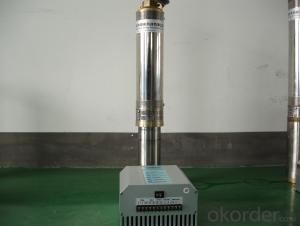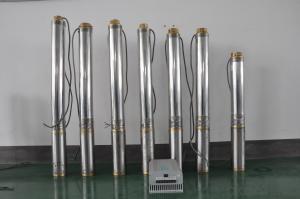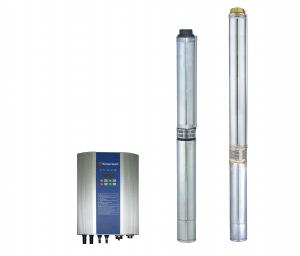DC Solar Pump
- Loading Port:
- China Main Port
- Payment Terms:
- TT OR LC
- Min Order Qty:
- -
- Supply Capability:
- -
OKorder Service Pledge
OKorder Financial Service
You Might Also Like
Item Description :
This superb new addition to our solar fountain range comes with a 10w solar panel,and a powerful fountain pump that is capable of producing fountains of up to 2m in height. As well as being easy to set up and use.Instruction manual is supplied for assembly and maintenance.
Solar Fountain Key Features :
Powered by direct sunlight
No high voltage electric mains required
Safe for children
Max. height of fountain: 2M
Max. flow capacity: 800 L/H(176 GAL)
10W Polycrystalline solar panel included
18V DC brushless pump
Solar Pump Features :
Can produce fountains up to : 2M (tube height) 1.4M (fountain height)
Comes with multiple nozzle accessories
Cable Length : 5M
Solar Panel Features :
10W peak power.
Polycrystalline highly efficient solar panel
Comes mounted in aluminium frame
Comes with ground stake and rotating knob so you can angle your panel toward the sun
What You Will Get :
10W solar panel
Solar pump
Ground Sake
Nozzle accessories
Precautions :
DO NOT alter or change the product itself or its components
Operate pump in freshwater only, never above 50 degrees celsius
Keep away from flammable liquids
Do not connect to any other power supply other than the included
- Q:What is the installation process for a solar pump?
- The installation process for a solar pump typically involves the following steps: 1. Site Assessment: Determine the optimal location for the solar panels and pump system by considering factors such as sunlight exposure, water source proximity, and accessibility. 2. Mounting the Solar Panels: Install the solar panels in a location where they can receive maximum sunlight exposure, typically on a roof, ground-mounted rack, or pole mount. 3. Wiring and Connection: Connect the solar panels to the pump controller using appropriate wiring and connectors. Ensure proper polarity and secure connections to avoid any electrical issues. 4. Mounting the Pump: Install the pump in the desired location, ensuring it is securely anchored. Connect the pump to the water source, such as a well or water storage tank. 5. Installing the Pump Controller: Mount the pump controller near the solar panels, ensuring it is protected from harsh weather conditions. Connect the pump, solar panels, and batteries (if applicable) to the controller. 6. Testing and Commissioning: Test the system by turning on the pump and checking for proper functionality. Adjust settings on the pump controller, such as flow rate or pressure, as needed. 7. Maintenance and Monitoring: Regularly inspect and clean the solar panels to maintain their efficiency. Monitor the system's performance, including water flow, power generation, and battery charge (if applicable), to ensure optimal operation. It is important to note that the specific installation process may vary depending on the type and model of the solar pump system and local regulations. It is advisable to consult the manufacturer's installation guidelines or seek professional assistance for a successful installation.
- Q:How does the tilt angle of the solar panel affect the performance of a solar pump?
- The tilt angle of a solar panel affects the performance of a solar pump by directly impacting the amount of sunlight it receives. A properly tilted solar panel can maximize the absorption of sunlight, leading to increased energy production and improved pump performance. On the other hand, an incorrect tilt angle can reduce the efficiency of the solar panel, resulting in lower energy output and decreased pump performance.
- Q:Can a solar pump be used in areas with water scarcity?
- Yes, a solar pump can be used in areas with water scarcity. Solar pumps are especially suitable for such areas as they operate solely on solar energy and do not require a constant electricity supply. They can extract water from various sources like wells, boreholes, or rivers, providing a sustainable and reliable solution for accessing water in regions where water scarcity is a concern. Additionally, solar pumps can be cost-effective and environmentally friendly, making them an ideal choice for addressing water scarcity challenges.
- Q:What is the expected lifespan of the motor used in a solar pump system?
- The expected lifespan of the motor used in a solar pump system can vary depending on factors such as the quality of the motor, maintenance practices, and environmental conditions. However, on average, a well-maintained motor in a solar pump system can be expected to last for around 10 to 15 years.
- Q:How to use solar panels to drive 50W of circulating water pump, what configuration needs, how to connect?
- Drive 50W of circulating water pump, it is clear that to drive the 50W pump, the solar panel power must be greater than the pump power, because the output power of the battery is unstable, determined by the weather is good, in order to pump work smoothly,
- Q:How does the efficiency of a solar pump vary with different head heights?
- The efficiency of a solar pump does vary with different head heights. The head height refers to the vertical distance between the water source and the pump outlet. Generally, as the head height increases, the efficiency of the solar pump decreases. This is because the pump needs to work against gravity to lift the water to a higher level, which requires more energy. As a result, the solar panel may need to produce more power to meet the increased demand, leading to a decrease in efficiency. Additionally, the efficiency of the solar pump can also be influenced by the design and quality of the pump itself. Different pumps have varying efficiency ratings, and it is important to choose a pump that is specifically designed to handle the desired head height effectively. It is worth noting that while the efficiency may decrease with higher head heights, solar pumps are still a viable and sustainable option for water pumping in areas with good solar irradiation. They offer several advantages such as being environmentally friendly, cost-effective, and independent of grid electricity. However, it is crucial to consider the specific requirements of the project and select a pump that is suitable for the intended head height to ensure optimal performance and efficiency.
- Q:Can a solar pump be used for water supply in agricultural or farming operations?
- Yes, a solar pump can be used for water supply in agricultural or farming operations. Solar pumps are an effective and sustainable solution for providing water to crops, livestock, and irrigation systems. By harnessing solar energy, these pumps eliminate the need for electricity or fuel, reducing operational costs and environmental impact. They can be used in remote areas with limited access to power grids and are particularly beneficial in regions with abundant sunlight. Solar pumps are reliable, efficient, and can help promote sustainable agriculture practices.
- Q:Are there any maintenance requirements for solar pumps?
- Solar pumps do require maintenance, although they are generally easier to maintain than traditional pumps. Regular maintenance is necessary to ensure optimal performance and longevity. To properly maintain a solar pump, the following tasks should be performed: 1. Clean the solar panels regularly to remove any accumulated dust, dirt, or debris. This will maximize the panels' efficiency and ensure sufficient power generation for the pump. 2. Periodically inspect the pump system, including the motor, pump, and connections, for any signs of damage or wear. Look out for loose or damaged wires, leaks, or any other issues that may affect pump performance. 3. Lubricate the moving parts of the pump as required. Follow the manufacturer's guidelines and recommendations to ensure smooth operation. 4. If the solar pump has a battery backup system, regular battery maintenance is crucial. This may involve checking battery levels, cleaning battery terminals, and replacing batteries if necessary. 5. It is advisable to have a professional service and inspect the solar pump system at least once a year. They can conduct more comprehensive checks, provide necessary repairs or replacements, and offer recommendations for optimal performance. By adhering to these maintenance requirements, solar pump owners can ensure efficient and effective operation, minimizing the risk of breakdowns and prolonging the pump's lifespan.
- Q:How does a solar pump help in reducing the use of chemical pesticides?
- A solar pump helps in reducing the use of chemical pesticides by providing a sustainable and eco-friendly alternative for irrigation. By utilizing solar energy, the pump powers the irrigation system, ensuring a consistent and reliable water supply for crops. This helps in maintaining optimal soil moisture levels, reducing the risk of pests and diseases. Additionally, solar pumps can be combined with drip irrigation systems, which deliver water directly to the plant's root zone, minimizing water wastage and preventing the spread of pests and diseases that often thrive in moist conditions. The reduced reliance on chemical pesticides not only promotes healthier and more sustainable farming practices but also contributes to a cleaner environment.
- Q:Can a solar pump be used in both residential and commercial applications?
- Yes, a solar pump can be used in both residential and commercial applications. Solar pumps are versatile and can be used to pump water for a variety of purposes such as irrigation, water supply, and wastewater management in both residential and commercial settings. They are an efficient and cost-effective solution for pumping needs in both sectors, utilizing renewable energy from the sun.
1. Manufacturer Overview |
|
|---|---|
| Location | |
| Year Established | |
| Annual Output Value | |
| Main Markets | |
| Company Certifications | |
2. Manufacturer Certificates |
|
|---|---|
| a) Certification Name | |
| Range | |
| Reference | |
| Validity Period | |
3. Manufacturer Capability |
|
|---|---|
| a)Trade Capacity | |
| Nearest Port | |
| Export Percentage | |
| No.of Employees in Trade Department | |
| Language Spoken: | |
| b)Factory Information | |
| Factory Size: | |
| No. of Production Lines | |
| Contract Manufacturing | |
| Product Price Range | |
Send your message to us
DC Solar Pump
- Loading Port:
- China Main Port
- Payment Terms:
- TT OR LC
- Min Order Qty:
- -
- Supply Capability:
- -
OKorder Service Pledge
OKorder Financial Service
Similar products
New products
Hot products
Related keywords




























